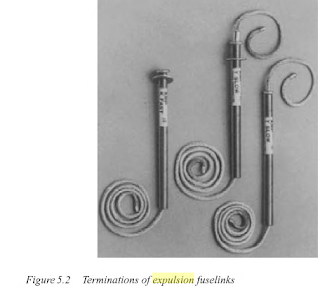Expulsion fuse
what is expulsion type fuse and how does it works?Expulsion fuse links contain a short element of 3 obtained copper wire in series with a flexible braid. These items are mounted in a fuse carrier incorporating a tube of organic material usually closed at the top with a frangible diaphragm and containing a liner of gases evolving material such as fiber. The fuse element carries a closely fitting sleeve of the gas generating fabric. The flexible bread is brought out of the open lower end of the tube and held in tension by a string attached to the lower end of the fuse base.
A cross-section through a typical Expulsion fuse link is shown in figure 5.1 and three popular physical connection arrangements designated button head double tail and universal are illustrated in figure 5.2. It will be seen that all these have a braid at the lower and it is being the upper terminations which differ.
The Expulsion fuse carrier has pins at the lower and which act as a hinge when it is mounted in the lower contacts of the fuse Mount.
In the service position, the fuse carrier is tilted from the vertical as can be seen from figure 5.3 which shows a complete assembly.
when the expulsion fuse element melts during operation, the release of the spring tension disengages a large that allows the fuse carrier to swing down by Gravity.
This provides isolation and prevents discharges along the tube which could lead to tracking it also indicates that operation has occurred.
Expulsion fuses are able to break a wide range of fault currents. when interrupting a small fault, the arc is extinguished within the fired film around the element, but at high current, this sleeve bursts and the arc is extinguished within the liner of gas evolving material. The diaphragm at the upper end of the fuse carrier ruptures when the current being interrupted is sufficiently high and Thus double end venting is provided, so relieving the fuse carrier tube of excessive pressure.
These Expulsion fuses are available for use in three phase circuits with current and line voltage ratings of 200 amperes and 72KV, respectively. Their maximum breaking capacity is typically limited to 150 MVA.
Expulsion fuses are for outdoor use only and they may be replaced using a pole from the ground. The pole can also be used to swing down the carrier of a healthy fuse for the purpose of isolation. It is necessary to be performed unless the equipment is arranged so that load current May be interrupted by the contacts. In some designs, this is done by including circuit breaker type arc chutes around the contacts which separate. An alternative, which is sometimes adopted is to use fuse links which are so designed that the element may be snapped mechanically by an operator inserting a pole in into it from the ground. The expulsion fuse link then functions in the normal way to clear the circuit after which the carrier may be swung down safely.




Comments
Post a Comment